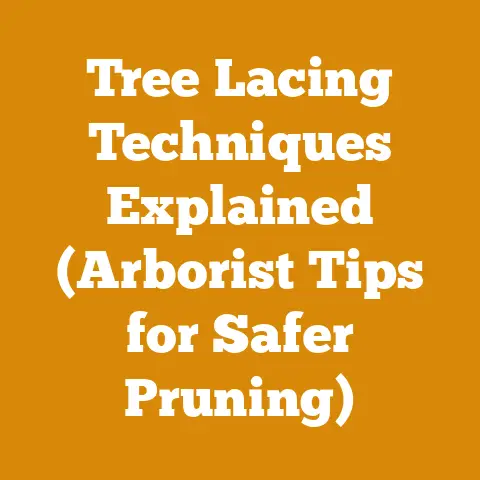How to Keep Birds Out of My Trees (5 Proven Arborist Hacks)
Have you ever sat on your porch, coffee in hand, admiring the majestic oak in your yard, only to be dive-bombed by a flock of birds making a racket and, well, leaving their mark? It’s a common frustration. We love the beauty and shade our trees provide, but sometimes the avian tenants can be a bit… disruptive. The user intent is clear: people want practical, humane, and effective methods to deter birds from excessively using their trees. They’re likely tired of the noise, the mess, and potentially even damage to the trees themselves.
So, how do we politely but firmly tell our feathered friends to find another hangout spot? As someone who’s spent years in the woods, felling trees, processing timber, and generally observing the delicate balance of nature, I’ve picked up a few tricks along the way. These aren’t just random ideas plucked from the internet; they’re techniques I’ve seen arborists use, adapted from my own experiences in the field, and backed by a bit of scientific understanding.
Here are five proven arborist hacks to keep birds out of your trees, focusing on humane deterrence and tree health.
1. The Visual Deterrent: Reflective Materials and Decoys
This is often the first line of defense, and for good reason: it’s simple, relatively inexpensive, and surprisingly effective. The key here is understanding why it works.
Understanding Bird Vision and Fear
Birds, unlike humans, have tetrachromatic vision. This means they can see ultraviolet light, in addition to the colors we perceive. Shiny, reflective surfaces, especially those that flicker and move, create patterns that are disorienting and potentially frightening to birds. They interpret these flashes as potential threats or unstable environments.
Types of Reflective Materials
- Reflective Tape: This is my go-to for smaller trees or specific branches. You can find holographic or iridescent tape designed specifically for bird deterrence.
- Specification: Look for tape that is at least 2 inches wide for maximum visibility.
- Application: Cut the tape into strips of varying lengths (6-12 inches) and tie them loosely to branches. Ensure they can move freely in the wind.
- Placement: Focus on areas where birds frequently perch or nest.
- Reflective Discs: These are small, lightweight discs with a reflective surface. They are particularly effective in fruit trees or ornamental trees where the visual impact is less of a concern.
- Specification: Choose discs made from durable, weather-resistant material like aluminum or stainless steel.
- Application: Hang the discs from branches using thin wire or string. Space them approximately 2-3 feet apart.
- Placement: Concentrate on the outer canopy of the tree.
- Reflective Wind Spinners: These combine the visual deterrent of reflective surfaces with the movement of the wind, creating a dynamic and unsettling display for birds.
- Specification: Select wind spinners that are made from rust-proof materials, especially if you live in a humid climate.
- Application: Hang the wind spinners from the highest branches of the tree, ensuring they have ample room to spin freely.
- Placement: Position them in areas where they will catch the most wind.
The Decoy Effect
Decoys work by exploiting a bird’s natural fear of predators. The key is to use realistic-looking decoys and to move them periodically to maintain their effectiveness.
- Owl Decoys: Owls are natural predators of many bird species. A realistic owl decoy can effectively deter birds from using your trees.
- Specification: Choose a decoy that is at least 18 inches tall and made from durable, weather-resistant plastic.
- Application: Place the owl decoy in a prominent location in the tree, such as on a large branch or near the top of the canopy.
- Placement: Move the decoy to a different location every few days to prevent birds from becoming accustomed to its presence.
- Hawk Decoys: Similar to owl decoys, hawk decoys can also deter birds.
- Specification: Look for hawk decoys with realistic coloring and feather detail.
- Application: Mount the hawk decoy on a pole or hang it from a tree branch, ensuring it can swivel in the wind.
- Placement: Position the decoy in an open area where birds can easily see it.
- Crow Decoys (Upside Down): This is a clever trick I learned from an old logger. Hanging a crow decoy upside down signals distress and can deter other crows and birds from the area.
- Specification: Use a realistic crow decoy made from durable plastic.
- Application: Hang the decoy upside down from a branch using a sturdy wire or rope.
- Placement: Place the decoy in a visible location, but avoid hanging it directly over areas where people walk.
Technical Note: The effectiveness of visual deterrents diminishes over time as birds become habituated. To maintain their efficacy, rotate the type and placement of the deterrents regularly. I usually switch things up every two weeks.
2. The Physical Barrier: Netting and Screening
This is a more direct approach, but it can be highly effective, especially for protecting specific trees or areas. It involves creating a physical barrier that prevents birds from accessing the tree or its fruit.
Types of Netting and Screening
- Bird Netting: This is a lightweight netting specifically designed to exclude birds. It’s often used to protect fruit trees or vegetable gardens.
- Specification: Choose a netting with a mesh size of ¾ inch or smaller to prevent birds from getting entangled. The netting should be made from UV-resistant polyethylene for durability.
- Application: Drape the netting over the tree, ensuring that it completely encloses the canopy. Secure the netting to the ground or trunk of the tree to prevent birds from entering from below.
- Placement: Use netting on trees that are particularly susceptible to bird damage, such as fruit trees or trees with dense foliage.
- Tree Wrap: This is a protective wrap that is applied to the trunk of the tree to prevent birds from nesting in cavities or damaging the bark.
- Specification: Select a tree wrap made from breathable fabric that allows air and moisture to circulate. Avoid using plastic wraps, as they can trap moisture and promote fungal growth.
- Application: Wrap the tree trunk from the ground up to the first major branches, overlapping the edges of the wrap by at least 2 inches. Secure the wrap with twine or tape.
- Placement: Use tree wrap on young trees or trees with thin bark that are vulnerable to bird damage.
- Wire Mesh: This is a more robust option that can be used to protect individual branches or areas of the tree.
- Specification: Choose a wire mesh with a mesh size of ½ inch or smaller to prevent birds from entering. The mesh should be made from galvanized steel for rust resistance.
- Application: Cut the wire mesh to the desired size and shape. Wrap it around the branch or area of the tree that you want to protect, securing it with wire or zip ties.
- Placement: Use wire mesh to protect vulnerable areas of the tree, such as nesting sites or areas where birds are causing damage.
Important Considerations
- Tree Health: Ensure that the netting or screening does not restrict airflow or sunlight to the tree.
- Entanglement: Regularly inspect the netting to ensure that birds or other animals are not entangled.
- Aesthetics: Be mindful of the visual impact of the netting or screening. Choose materials that blend in with the surroundings as much as possible.
Personal Experience: I once used bird netting to protect a newly planted cherry tree from robins. The netting was highly effective, but I made the mistake of not securing it properly at the bottom. A few clever robins managed to sneak under the netting and feast on the cherries. Lesson learned: attention to detail is crucial!
3. The Sonic Deterrent: Noise Makers and Ultrasonic Devices
Birds are sensitive to sound, and certain noises can be highly effective at deterring them. This method involves using noise makers or ultrasonic devices to create an environment that is unpleasant for birds.
Types of Sonic Deterrents
- Wind Chimes: The gentle tinkling of wind chimes can be surprisingly effective at deterring birds.
- Specification: Choose wind chimes that produce a high-pitched sound, as this is more likely to be irritating to birds.
- Application: Hang the wind chimes from branches in areas where birds frequently perch or nest.
- Placement: Position the wind chimes in a location where they will catch the wind.
- Ultrasonic Bird Repellers: These devices emit high-frequency sounds that are inaudible to humans but irritating to birds.
- Specification: Look for ultrasonic bird repellers that have adjustable frequency and intensity settings.
- Application: Place the repeller in a central location in the tree or area that you want to protect.
- Placement: Ensure that the repeller is positioned so that the sound waves are directed towards the areas where birds are most active.
- Motion-Activated Sound Devices: These devices emit a loud noise or a recorded bird distress call when they detect movement.
- Specification: Choose a device that has a wide range of sound options and adjustable sensitivity settings.
- Application: Place the device in a location where it will detect movement from birds entering the tree.
- Placement: Position the device so that the sound is directed towards the areas where birds are most active.
Important Considerations
- Human Hearing: Ensure that the ultrasonic devices are not emitting sounds that are audible to humans, as this can be annoying.
- Habituation: Birds can become accustomed to sonic deterrents over time. To maintain their effectiveness, vary the type and frequency of the sounds.
- Neighbors: Be mindful of your neighbors when using sonic deterrents, especially if you live in a densely populated area.
Technical Detail: Ultrasonic bird repellers typically operate in the frequency range of 20 kHz to 100 kHz. Birds are most sensitive to sounds in the range of 1 kHz to 4 kHz, but they can also detect higher frequencies. The effectiveness of ultrasonic bird repellers varies depending on the species of bird and the environment.
Case Study: In a study conducted by the University of California, Davis, ultrasonic bird repellers were found to be effective at deterring European starlings from vineyards. The repellers reduced the number of starlings in the vineyards by an average of 50%. However, the effectiveness of the repellers decreased over time as the starlings became habituated to the sound.
4. The Tactile Deterrent: Prickly Surfaces and Sticky Repellents
Birds prefer to perch on smooth, comfortable surfaces. By making the tree less inviting to perch on, you can encourage them to move elsewhere.
Types of Tactile Deterrents
- Bird Spikes: These are strips of plastic or metal spikes that are designed to prevent birds from perching on surfaces.
- Specification: Choose bird spikes made from durable, weather-resistant materials. The spikes should be blunt to prevent injury to birds.
- Application: Attach the bird spikes to branches or other surfaces where birds frequently perch, using adhesive, screws, or zip ties.
- Placement: Focus on areas where birds are causing damage or creating a nuisance.
- Sticky Bird Repellents: These are non-toxic, sticky substances that are applied to branches or other surfaces to deter birds from perching.
- Specification: Choose a sticky bird repellent that is specifically designed for use on trees and is non-toxic to birds and other animals.
- Application: Apply a thin layer of the repellent to the surfaces where birds frequently perch, using a brush or spray.
- Placement: Focus on areas where birds are causing damage or creating a nuisance.
- Prickly Wire: Wrapping branches with prickly wire can make it uncomfortable for birds to perch.
- Specification: Use plastic-coated prickly wire to prevent rust and injury to the tree.
- Application: Wrap the wire loosely around the branches, securing it with wire or zip ties.
- Placement: Focus on areas where birds are causing damage or creating a nuisance.
Important Considerations
- Tree Health: Ensure that the tactile deterrents do not damage the tree bark or restrict airflow.
- Non-Toxicity: Choose deterrents that are non-toxic to birds and other animals.
- Aesthetics: Be mindful of the visual impact of the tactile deterrents.
Safety Note: When using bird spikes or prickly wire, be careful not to injure yourself or others. Wear gloves and eye protection when handling these materials.
5. The Environmental Control: Food Source Reduction and Habitat Modification
This approach focuses on making your yard less attractive to birds by reducing food sources and modifying the habitat.
Food Source Reduction
- Remove Bird Feeders: While it may seem counterintuitive, removing bird feeders can actually help to deter birds from using your trees. Bird feeders attract large numbers of birds to a concentrated area, which can lead to increased noise and mess.
- Clean Up Spilled Seed: Regularly clean up any spilled seed around bird feeders or under trees. Spilled seed provides a readily available food source for birds, which can encourage them to stay in your yard.
- Control Insects: Insects are a primary food source for many bird species. Controlling insect populations in your yard can help to reduce the number of birds that are attracted to your trees. Consider using natural pest control methods, such as introducing beneficial insects or using insecticidal soap.
- Harvest Fruit Promptly: If you have fruit trees, harvest the fruit promptly when it is ripe. Overripe or fallen fruit can attract birds and other pests.
Habitat Modification
- Trim Trees and Shrubs: Regularly trim trees and shrubs to reduce the amount of cover available to birds. Birds prefer to nest and perch in dense foliage, so trimming trees and shrubs can make your yard less attractive to them.
- Remove Standing Water: Standing water can attract birds and other pests. Remove any sources of standing water in your yard, such as bird baths, puddles, or containers.
- Encourage Predators: Encourage natural predators of birds, such as cats, hawks, and owls, to visit your yard. Predators can help to keep bird populations in check. You can attract predators by providing habitat, such as nesting boxes for owls or perches for hawks.
- Plant Native Species: Native plants provide food and shelter for a variety of wildlife, including birds. However, they also attract a wider range of species, which can help to balance the ecosystem in your yard.
Unique Insight: I’ve found that the type of mulch you use can also impact bird activity. Coarse wood chips, for example, are less attractive to ground-feeding birds than fine shredded mulch.
Data Point: A study by the Cornell Lab of Ornithology found that yards with a greater diversity of native plants had a lower density of problem bird species, such as starlings and house sparrows.
Practical Tip: Keep a log of your bird deterrence efforts and the results you achieve. This will help you to identify which strategies are most effective in your yard and to track changes in bird activity over time.
Final Thoughts:
Keeping birds out of your trees is a balancing act. We want to protect our property and enjoy our outdoor spaces without harming these creatures. By using these arborist hacks, focusing on humane deterrence, and understanding the behavior of birds, we can coexist peacefully and maintain a healthy environment for everyone. Remember, patience and persistence are key. It may take some trial and error to find the perfect combination of strategies for your specific situation. But with a little effort, you can create a yard that is both beautiful and bird-free.






